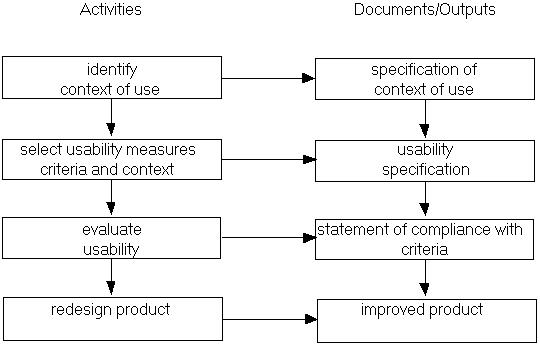|
6.1. Specification of overall requirements for a product Information about the characteristics of users, their goals and tasks and the environments in which the tasks are carried out provides important information for use in the specification of overall product requirements, prior to development of specific usability requirements. 6.2. Specification of usability requirements for a product Prior to development of a custom system, a purchasing organisation can use the information in this part of ISO 9241 as a framework for specifying the usability requirements which the system must meet and against which acceptance testing may be carried out. Specific contexts in which usability is to be measured should be identified, measures of effectiveness, efficiency and satisfaction selected, and acceptance criteria based on these measures established (an example is given in Annex C). 6.3. Product development The definition and framework for usability can be used by product development teams to establish a common understanding of the concept of usability, and can help product development teams address the breadth of issues associated with product usability. A developer can use the guidance in this part of ISO 9241 to helpspecify usability targets for the product (see Annex C). At various stages during the development process the developer can measure the usability achieved against these targets. This information enables objective decisions to be taken about the need for design changes to enhance usability, and about trade-offs which may be appropriate between usability and other requirements. 6.4. Specification or evaluation of product attributes The guidance on context of use can be used to identify the users, tasks and environments so that more accurate judgements can be made about the needs for particular product attributes. 6.5. Usability measurement This part of ISO 9241 provides information to support measurement of usability. For example, description of the characteristics of users can assist with the selection of users to participate in evaluation. Identification of user's goals can assist with the selection of appropriate tasks for usability testing or reviews. The characteristics of the environment in which a product is likely to be used need to be described if that environment has to be simulated to ensure the validity of test results. This part of ISO 9241 also provides a basis from which measures of usability can be generated. Product developers can develop appropriate measures of efficiency, effectiveness, and/or satisfaction (see Annex B). 6.6. Quality system The activities listed in 6.1 to 6.5 can provide a basis for defining, documenting and verifying usability as a part of a quality system. For example, Figure 2 illustrates how usability can be incorporated into a quality system which conforms to ISO 9001. 
Figure 2 Quality Plan 6.7. Comparative evaluation of products This part of ISO 9241 can be used to help structure comparative evaluations of usability. Evaluators can use this part of ISO 9241 to identify which parts of the context of use (the users, their tasks, and the environment of use) need to be controlled when conducting comparative evaluations. The comparative user performance test methods in the Annexes of parts 3 and 4 of ISO 9241 are examples of usability evaluation for the purpose of equivalence testing of a product (display screen or keyboard). These test methods, which are intended to provide alternative means of testing conformance, enable a manufacturer to demonstrate the usability of a new product by showing that, in a specific context of use, the measures of usability with the product are at least as good as the measures of usability with a product which has physical attributes which are known to meet the requirements of the standard. A purchasing organisation can use the guidance in this part of ISO 9241 to help choose between products already available. Having specified the usability requirements in terms of the intended context of use and which measures of effectiveness, efficiency and satisfaction are to be used, the guidance may then be used to specify test conditions and evaluation criteria. The test conditions should be representative of important aspects of the overall context of use. 6.8. Use with other standards Other parts of ISO 9241, such as Part 14, contain recommendations which are applicable in particular contexts of use. The guidance in this part of the standard can be used to provide a framework for identifying the context of use which is relevant to the design decision to be made. Annex D contains more information on the relationship with other parts of ISO 9241 and other standards. | 